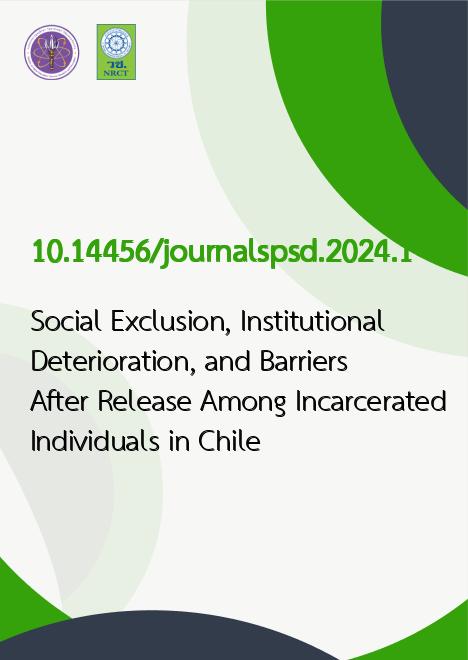
|
Social Exclusion, Institutional Deterioration, and Barriers After Release Among Incarcerated Individuals in Chile |
|---|---|
| รหัสดีโอไอ | |
| Creator | Guillermo E. Sanhueza |
| Title | Social Exclusion, Institutional Deterioration, and Barriers After Release Among Incarcerated Individuals in Chile |
| Publisher | Faculty of Social Administration, Thammasat University |
| Publication Year | 2567 |
| Journal Title | Journal of Social Policy, Social Change and Development |
| Journal Vol. | 2 |
| Journal No. | 2 |
| Page no. | 1-22 |
| Keyword | Social exclusion, Recidivism, Predictors, Chile |
| URL Website | https://so10.tci-thaijo.org/index.php/journalspsd/issue/view/179 |
| Website title | Journal of Social Policy, Social Change and Development |
| ISSN | 2985-0800 |
| Abstract | This study analyzes how social exclusion, prison experiences and barriers after release altogether conspire against a successful re-entry of a sample of incarcerated individuals in Chile. A methodological combination of reviewing previous literature on social exclusion of the incarcerated, the analysis of administrative data and prison surveys, along with geocoded data was employed. We analyzed the data based on descriptive statistics, logistic regression models (to predict recidivism or not), and the creation of maps to examine the possible overlap between recidivism of released individuals and social disadvantaged areas of different cities in Chile. Our main findings suggest that incarcerated individuals had higher levels of social exclusion before entering to prison; once incarcerated, they experience harsh conditions that amplify initial handicaps; finally, after release, a 43.2% of incarcerated individuals in our cohort was sent to prison again, consistent with national estimates. In terms of predictors, our findings show the crucial role of prison officers and guards in reducing recidivism, especially through a well-functioning facility, and by establishing an appropriate relationship with the incarcerated. On the other hand, variables predicting recidivism were experiencing boredom inside the facility, being male, young, having been incarcerated before and having previously lived in state “protective” services. At the territorial level, there was an overlap between territorial disadvantage and recidivism, a trend that increased as the size of the city enlarged. In terms of policy implications, our findings suggest the importance of departing from an idea of individually-determined risk when attempting to manage anti-recidivism strategies, which should enhance indicators and experiences of social inclusion at different stages: strengthening diversion programs (before), enhancing program access (during incarceration), and coordinating services between prisons and local governments previous to the release (after incarceration). |